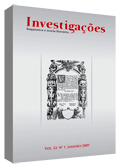Marcas da ordem patriarcal em São Bernardo: o dilema do favor
Abstract
Este artigo vale-se da lógica do favor de Roberto Schwarz, dos conceitos núcleo/ nebulosa de Roberto Reis e do binômio ordem/desordem de Antonio Candido, para discutir a permanência de alguns valores patriarcais no romance S. Bernardo (1934), escrito por Graciliano Ramos.References
CANDIDO, Antonio. 199?. Dialética da malandragem. In: ALMEIDA, Manuel Antônio de. Memórias de um sargento de milícias. São Paulo: Círculo do Livro.
______. 1992. Ficção e confissão: ensaios sobre Graciliano Ramos. São Paulo: Ed. 34.
GLEDSON, John. 1991. Impostura e realismo: uma reinterpretação de Dom Casmurro. Trad. Fernando Py. São Paulo: Companhia das Letras.
MALARD, Leticia. 1976. Ensaio de literatura brasileira: ideologia e realidade em Graciliano Ramos. Belo Horizonte: Itatiaia.
RAMOS, Graciliano. 2004. S. Bernardo. Posf. de Godofredo de Oliveira Neto. 78. ed. rev. Rio de Janeiro: Record.
REIS, Roberto. 1987. A permanência do círculo: hierarquia no romance brasileiro. Niterói: EDUFF; Brasília: INL.
ROCHA-COUTINHO, Maria Lúcia. 1994. Tecendo por detrás dos panos: a mulher brasileira nas relações familiares. Rio de Janeiro: Rocco.
SCHWARZ, Roberto. 1992. Ao vencedor as batatas: forma literária e processo social nos inícios do romance brasileiro. São Paulo: Duas Cidades.
SÜSSEKIND, Flora. 1984. Tal Brasil, qual romance: uma ideologia estética e sua história: o naturalismo. Rio de Janeiro: Achiamé.
Downloads
Published
How to Cite
Issue
Section
License
Copyright (c) 2009 Marcos Hidemi de Lima

This work is licensed under a Creative Commons Attribution 4.0 International License.
Authors who publish with Revista Investigações agree to the following terms:
Authors retain copyright and grant the journal right of first publication with the work simultaneously licensed under the Creative Commons Attribution 4.0 International (CC BY 4.0) license that allows others to share the work with an acknowledgement of the work's authorship and initial publication in this journal.
Authors are able to enter into separate, additional contractual arrangements for the non-exclusive distribution of the journal's published version of the work (e.g., post it to an institutional repository or publish it in a book), with an acknowledgement of its initial publication in this journal.
You are free to:
Share — copy and redistribute the material in any medium or format for any purpose, even commercially.
Adapt — remix, transform, and build upon the material for any purpose, even commercially.
The licensor cannot revoke these freedoms as long as you follow the license terms.
Under the following terms:
Attribution — You must give appropriate credit , provide a link to the license, and indicate if changes were made . You may do so in any reasonable manner, but not in any way that suggests the licensor endorses you or your use.
No additional restrictions — You may not apply legal terms or technological measures that legally restrict others from doing anything the license permits.

